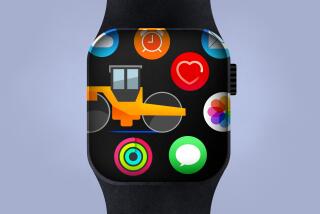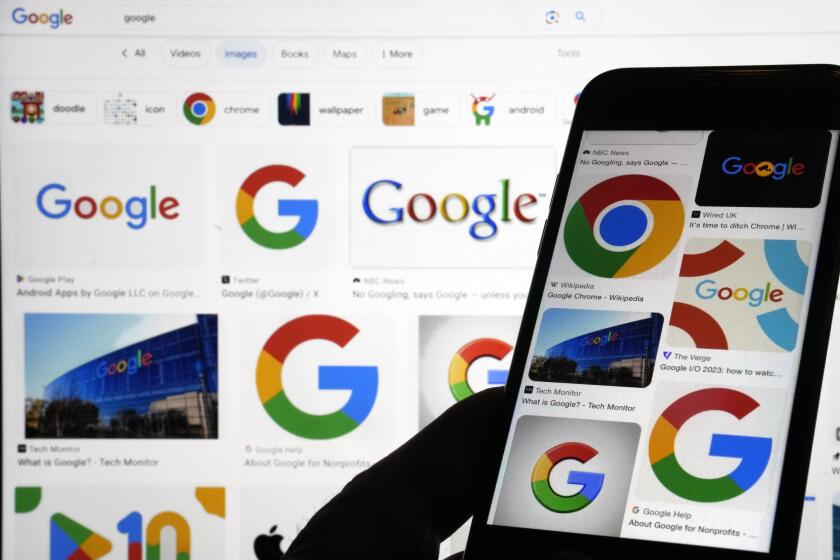Not All of Computer Pie Is Apple : No. 2 in PCs Is Still Falling Behind in Business Market
If this story were being written on a Macintosh Plus computer, it would be a cinch to draw little pie charts right here to show how Apple Computer fared last month in sales through computer retail outlets.
The Mac would be given the percentages for the major companies, with Apple’s share at 37%--a pretty healthy slice. The pie would show IBM with 24%, Compaq with 9% and AT&T; with 6%. The eagerly anticipated Amiga from Commodore had only 2%; the remaining area, or about 22% of the whole pie, would be labeled “all others.”
Jazzy Graphics
For a comparison, we could open up another “window” on Mac’s screen to draw another pie. This one would show that, in December, 1984, Apple had almost half the pie--47%. IBM was second with 29%, Compaq would have a 4% share, and one teensy, 1% sliver belonged to AT&T.; The “all others” chunk was 19%. To finish it off, we could add a boldface title to show the charts are based on numbers of computers sold, rather than dollars spent, and a credit line--perhaps in an italic script--for Infocorp, the Cupertino, Calif., market research company.
The computer could drop the two pie charts into the text of the story and in one document illustrate the virtues of the Macintosh--speed, power, ease of use and jazzy graphics--and, at the same time, the challenge facing Apple Computer.
The computer industry looks forward to a revival of sorts in 1986, which means the whole pie will get bigger. Infocorp estimates worldwide sales of desk-top computers at $53 billion--a 35% increase. Apple, on the other hand, is anticipating its revenue to match--but not necessarily better--the $1.9 billion that it recorded in 1985. If the industry’s sales grow, but Apple’s do not, that means Apple’s slice will get even smaller this year.
Analysts see that as a trend that could deeply bruise Apple. Although it is the second-largest seller of personal computers, it has yet to find a firm footing in the business office, a segment of the market that is the most lucrative now and looks to be for quite some time.
Much, but not all, of Apple’s trouble with the business market stems from the incompatibility of its machines with IBM’s. Also, businesses do most of their buying through direct sales--IBM’s forte--and very little through computer retailers, where Apple now does almost all of its selling.
“I think (Apple is) planning not to have an increased share,” said Richard Matlack, president of Infocorp. “They’ll be biding their time in 1986 as they finish developing new products and then be ready for above-normal expansion in 1987.”
Steer Attention to Profits
Apple, however, would rather steer the attention away from market share and to profits. Profitability, said a spokeswoman, is “the thing we can control. . . . We have structured our company so that we don’t need revenue growth in order to be profitable.” The Cupertino-based company says it can “significantly” increase its profits this year and, indeed, in the first quarter of its fiscal year, posted 23% higher earnings on sales that were down 23%.
Apple chastens skeptics by saying it is a “very financially solid member of the Fortune 500, and will remain so.” And analysts generally have praised the way Apple confronted its own vulnerability to the industry’s slump last year. Heading into its annual meeting Wednesday, Apple is riding a crest of good news. In a four-day period earlier this month, it reported the record quarterly profits, unveiled its Mac Plus and LaserWriter Plus products during a well-executed and seemingly successful Apple World Conference and reached a settlement in its petulant suit against its former chairman, Steven P. Jobs.
President John Sculley, who recently said “1985 was the hardest year I’ve ever had in my whole life,” looks thinner and paler. But come Wednesday, he can report to shareholders that Apple is in fine fettle, with a fistful of cash ($441.5 million), a debt-free balance sheet and vastly improved profit margins.
Settling Dust
The dust seems to be settling from the $40-million reorganization that set the company on its ear last summer; insiders and outsiders alike report that morale has rebounded from the lows it hit during plant closings, massive layoffs and Jobs’ ouster and eventual resignation.
Although some of the “wacko frills are gone, it’s still really pretty loose--a happy place to work,” believes Michael Murphy, editor of California Technology Stock Letter. Murphy said that combining the two product groups (the Macintosh and the older Apple II line) into one unit has helped to galvanize the staff. “They’re working hard right now. Everybody felt like a survivor who got to stay there.”
David Fradin of Dataquest, a San Jose-based market research company, said: “It’s my belief that people can perform well, no matter what the (company) structure is like, if they’re good people. And Apple has good people.”
Analyst Jan Lewis of Palo Alto Research Group terms the reorganization and redirection, hard won by Sculley, the “Scullification of Apple.” The recently announced trade-in deals for owners of discontinued Apple products, the vow to “open” Macintosh to allow easy connection to other vendor’s peripheral products and the alliances with heavyweight companies such as Northern Telecom and Prime Computer all mean that Apple is the “best positioned it’s ever been to be taken seriously” in the business market--a stated Sculley goal.
Viewed as Serious
Sculley said Apple will have to be viewed as a serious company that “earns” its way into business. It won’t be easy: Whereas in 1984, Apple had 9% of sales of personal computers to businesses, in 1985, it dropped to a 3.4% share, according to Fradin. Echoing other analysts, Fradin said: “They’re not keeping up with the market’s growth.”
Often, said Infocorp’s Matlack, it is new products that stimulate the market’s growth. And here, too, Apple is behind. “Apple doesn’t really have a true new product,” Matlack said. The recently introduced Macintosh Plus and LaserWriter Plus are more evolutionary--enhancements of existing products. IBM, on the other hand, is expected to have new products in 1986 that will spark some market growth; a lap-top computer and a possible re-entry into the home/consumer market have been rumored.
Apple believes it can make a viable market out of desk-top publishing, in which the computer and a printer are used to produce high-quality publications such as brochures and in-house communications. Its Mac Plus and LaserWriter Plus, which together can be purchased for about $10,000, will have barely a six-month lead on that market, analysts say, forecasting that both IBM and office-copying pioneer Xerox will jump in.
Its best bet, Apple and analysts agree, will be small- and medium-size businesses, those companies that don’t already have IBM machines that they want to hook into. That market has the most potential, but is among the hardest to reach. And, dealers often point out, it takes almost as much time and effort to sell one computer to a company as it does to sell 25 or 100. Apple has been strengthening its relationships with dealers but still lacks a definitive strategy to reach the vast small-business market.
Education Market
And, too, analysts warn that Apple’s grip on the education market is being challenged, especially by Tandy. “Apple cannot take for granted the strong vendors like IBM and Tandy that want to be in that market,” Lewis said. “In this business, you always have to be looking over your shoulder.”
Apple contends it is not about to neglect the education market and has begun providing special incentives to dealers who sell mainly to schools--a move that elicits nods from many analysts. “Segmenting the dealers is a step in the right direction,” said Murphy of the Stock Letter.
In the home or consumer market, the Apple II line of products, which continues to contribute the lion’s share of Apple revenue, is seriously outdated and faces fierce competition and pricing pressures from companies like its old rivals Commodore and Atari. Those companies, pummeled when the market for game-oriented computers collapsed, are finding moderate success with its new upscale machines. Also, as the number of smaller competitors increases, the “all others” share of the pie grows, nicking away at the market leaders’ shares, noted Matlack.
Sculley has said that new products in the Apple II line will be introduced later this year, but analysts expect those, too, will be evolutionary in nature.
Business Standard
Apple’s approach to the consumer market has been closely linked to its lead in education, presuming that parents will choose the computer that their children use at schools. But the latest shift in consumer preference is toward work-at-home uses for computers, which tends to favor the dominant business standard: IBM and compatibles like Compaq.
“Apple is not watching for that trend, and it may be blind-sided,” said Dataquest’s Fradin.
So Apple is bumping up against the IBM bugaboo in the home as well as the office. Sculley’s program for the company to be taken seriously has helped its image. He has worked hard to redress the offense given in Apple’s controversial 1985 commercial for Macintosh, in which corporate computer buyers were portrayed as lemmings. When Jobs left, Apple adopted a stiff, businesslike posture, letting it be known that Jobs took with him the quirkiness and arrogance that he and Apple had been known for.
Having two of the “Big Eight” accounting firms choose Macintoshes for their field auditors has provided testimony that some companies do in fact take Apple seriously.
Robert Temkin, director of auditing standards for the Arthur Young accounting firm, said: “I’ve heard everything that everyone else has heard about Apple . . . and I’ve had to work closely with a number of people at Apple. I find the people very businesslike. Sure, they’re still different, but anybody in the high-tech business is different, just as anybody from the West Coast is going to be different.”
Software Program
Arthur Young said earlier this month that, not only would it be using Macintoshes in its field offices, it would be marketing its own auditing software program for the Mac.
At Peat, Marwick, a company that has more than 5,500 Macintoshes, audit partner Richard Webb said: “Corporate America says the Macintosh is not a business machine. But we’re a big business, and we’ve used the Macintosh to do business for two years.”
More companies, however, have been thinking like American Hospital Supply (now part of Baxter Travenol), which has favored IBM. Carl Steiner, director of information systems planning for the company, said Apple’s problems with discontinued or late products and its flaky image may have been a factor in the company’s decision not to consider major purchases of Apples. But he cited IBM’s abandoned PCjr, and said, “Apple is not any worse.”
The primary reason Apples were “not considered in large quantity,” Steiner said, is because they can’t connect to the company’s IBM mainframes and personal computers and its Digital Equipment minicomputers. “They’re obviously the other company to watch,” he said, “but they’re not on our buy list right now.”





